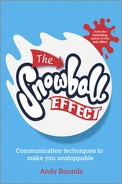21
When you want to write a winning proposal or sales presentation
Some of the most boring communications I’ve ever seen have been proposals and sales presentations – overlong, too detailed, minimal focus on the customer, similar to the competition’s, and similar to proposals the sales team sent to a different customer last week.
It would be a real shame if any communication was this ineffective. But, with something that’s supposed to convince a customer to choose you ahead of the competition? Well, that’s more than a shame.
This chapter shows how to bring your content together in a persuasive, compelling structure so the customer knows you can help them. You’ll notice that this structure follows ABCDE described in the previous chapter.
I’ve split it into the two common situations where you:
- Are starting a sales communication from scratch; and
- Have a first draft in your hand, and need to improve it quickly.
But, before that, here are three important guidelines with proposals.
1. Don’t write proposals too early
It’s usually easier to convince someone verbally than in writing.
So keep talking with the customer until you’ve both agreed a way you could work together. And only then send a proposal which confirms your discussions.
The alternative – less discussion and an earlier proposal – means the document has to do most of the convincing. This isn’t as likely to work. By definition, the proposal will be longer and probably contain irrelevant content.
2. Ask the customer about content
The easiest way to persuade a customer is by giving them the information they need to make a decision in your favor.
And the easiest way to discover what this information is? Ask them (“What information do you want to see? Would you like it detailed or in overview?” And so on).
3. Agree follow-up times in advance
Recognize this?
You send a proposal. The customer says they’ll get back to you. They don’t. Do you chase (and feel like you’re pestering) or wait (and feel like you’re powerless, and that you’ve been forgotten).
It’s far easier to agree before you send the proposal when you’ll speak after it: “I’ll create a proposal based on what we’ve agreed and send it over tomorrow. When would you suggest we discuss it?”
Creating Sales Communications from Scratch
Sales communications often start with “About us” and end with “How we can help you”. In other words, we talk about us first, and the customer second. This doesn’t work:
- It’s boring.
- The most interesting thing comes at the end, when they’ve probably switched off.
- Your competition probably did exactly the same thing.
- The customer perceives that you think you’re more important than they are.
The following table shows how to structure your sales communications – both proposals and presentations – in a better way. By way of example, I’ve assumed that the customer has three AFTERs which, in order of priority, are to:
Why not print off one of your recent sales communications, compare it with this table, and see how it stacks up?



This table is very useful to help prepare a proposal from scratch. But here’s what to do when you’ve been asked to improve something that’s already written . . .
Editing First Drafts Quickly
Recognize any of these?
- Someone sends you their slides at 10pm the night before your presentation.
- A colleague supplies the information you requested in the wrong format, a couple of days after the deadline you gave them.
It’s no wonder we often have to edit sales communications so quickly!
To do this, review them through the customer’s eyes (see the left-hand column below), and make the necessary adjustments (in the right):



